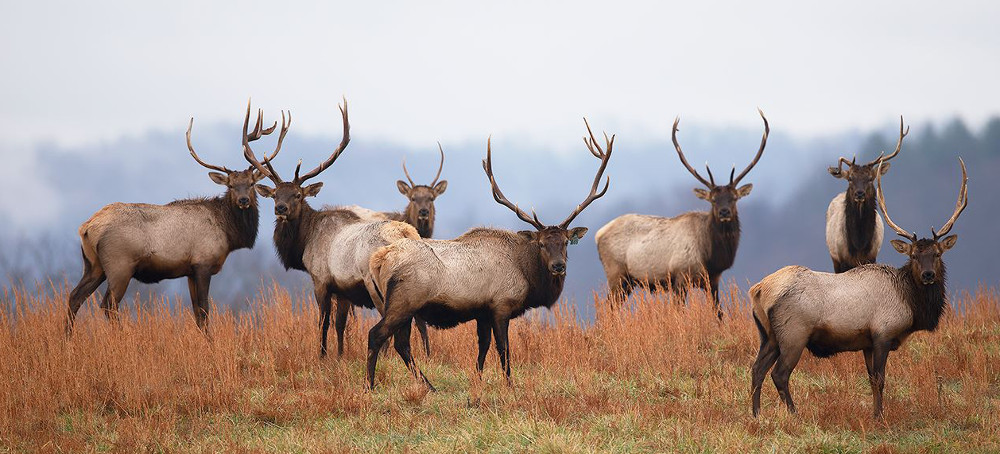Elk Were Decimated in the Eastern US Now a Herd Is Thriving in Virginia.
Dana Hedgpeth The Washington Post A bachelor group of male elk, called bulls, stands on reclaimed coal mine land in Buchanan County, Va. (photo: Mike Roberts)
A bachelor group of male elk, called bulls, stands on reclaimed coal mine land in Buchanan County, Va. (photo: Mike Roberts)
Elk once roamed the eastern part of the United States in the 1600s but were nearly wiped out by over-hunting
Now — a decade after wildlife officials reintroduced them in southwest Virginia — there’s a herd of more than 250 elk in the region.
“It’s a wildlife success story for this species,” said Jackie Rosenberger, elk project leader for the Virginia Department of Wildlife Resources. “A lot of folks think elk are just a species that’s found in the Western part of the U.S., but that’s not the case. That’s not their history, and through a large restoration effort we’ve managed to bring them back.”
Starting from late August to October is the best — and most interesting — time to see elk, experts said. They start their mating season around the early fall, and male elk, called bulls, let out a unique “bellowing call” when trying to attract a female.
“When you hear that bugling, it’s the most wild sound ever,” Rosenberger said. “It defines nature.”
She said the bulls also make the bugle sound to “warn other males that ‘I’m big and bad. Stay away from me.’ ”
In the fall, she said, it’s a good time to see — and hear — the elks because they’re so focused on breeding that they care less about people being around: “They’re only focused on one thing.”
For those who want to make the trip, there are three viewing spots in Virginia’s Buchanan County, about six hours from D.C. and west of Blacksburg. There are also several options for guided tours.
Elk are large animals and require shade to keep their body temperature regulated, so experts advise the best time for seeing them is early mornings after sunrise and evenings at dusk.
Rarely are they seen during the middle of the day, especially in warmer weather. They tend to bed down in forested areas or dense vegetation. As the daytime temperatures get cooler, they’re likely to come out and roam more, looking for food, experts said. If lucky, a viewer can see 50 elk in a herd together.
Officials with Virginia’s wildlife agency recently launched an elk webcam that allows viewers to watch the herd. For the past few years, the webcam has attracted about 50,000 views per year, officials said. The camera typically runs until late December and allows viewers a unique chance to see female elk, or cows as they’re called, come back from their “calving areas” with their young to more open fields.
Elk were once common before the 1600s across eastern North America, and in Virginia they were found mainly west of the Blue Ridge Mountains. But they were over-hunted and their habitats were destroyed by the late 1800s. The last known elk to be harvested in Virginia was in 1855, according to Virginia wildlife authorities.
As with a lot of other species, there was no regulated hunting, “so it was just ‘willy-nilly’ on harvesting elk,” Rosenberger said. “People were just hunting with no limits.”
She said people also drastically altered the elk habitats, further contributing to their near demise.
In 2012, an effort was launched — involving more than a half-dozen partners, including the Rocky Mountain Elk Foundation, Southwest Virginia Sportsmen and landowners in Buchanan County — to bring elk back in Virginia. Seventy-one adult elks and four calves were brought from nearby southeastern Kentucky to the Buchanan County area.
Elk need forested areas to protect themselves from heat and people, as well as nearby access to fields of grass and plants to eat.
So experts in Virginia worked to clean and restore about 2,600 acres previously used for coal mines to create a good habitat for the herd. Elk are on reclaimed mine land in other parts of the country as well, including in West Virginia, Kentucky, Pennsylvania and parts of Tennessee.
Strip mining for coal involves clearing a mountaintop of trees and vegetation. Experts said there are strict rules in place for making sure mining companies follow regulations after they’re done mining in an area for it to be cleaned and reused for other purposes. The mining, or mountaintop removal as it is commonly called, “involves removing earth to expose the coal beds and later putting the earth back where it was,” said Rosenberger. She said the land, once reclaimed, is safe for elk and other wildlife to inhabit.
“Mining doesn’t look pretty when it’s actively occurring but after it’s reclaimed,” she said, “it has made for some excellent early successional habitat.”
In Virginia, the rehabilitated land, with partly wooded areas, has provided an ideal spot for wildlife — including white-tailed deer, birds, wild turkeys, insects and black bears — and the elk herd, which roams more than 10,000 acres, stretching across Buchanan, Dickenson and Wise counties.



